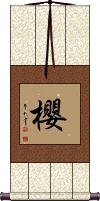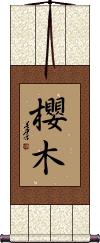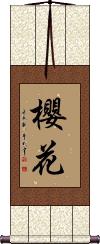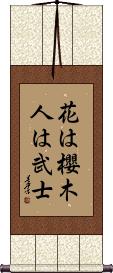Many custom options...
And formats...

櫻 in Chinese / Japanese...
Buy an 櫻 calligraphy wall scroll here!
Personalize your custom “櫻” project by clicking the button next to your favorite “櫻” title below...
Cherry Blossom / Sakura
櫻 is the single-character (short) way to write “cherry blossom” or “cherry tree” in Chinese and traditional Japanese Kanji.
![]() There is an alternate version of this character, which has become the standard for Japanese Kanji. If you want this version, instead of the one shown to the upper left, please click on the Kanji shown to the right instead of the button above. Although this is an alternate form in Chinese, most Chinese people will think this is just the Japanese version (Chinese people
don’t
necessarily know the history and all alternate forms of Chinese characters from the past). Therefore, this version shown to the right is best if your audience is Japanese (though most Japanese will recognize the form shown in the upper left).
There is an alternate version of this character, which has become the standard for Japanese Kanji. If you want this version, instead of the one shown to the upper left, please click on the Kanji shown to the right instead of the button above. Although this is an alternate form in Chinese, most Chinese people will think this is just the Japanese version (Chinese people
don’t
necessarily know the history and all alternate forms of Chinese characters from the past). Therefore, this version shown to the right is best if your audience is Japanese (though most Japanese will recognize the form shown in the upper left).
Sakuragi
Cherry Blossom
櫻花 is how to write “cherry blossom” in Chinese and traditional Japanese Kanji.
The first character means “cherry” or sometimes “cherry tree.”
The second character means “flowers” or “blossoms.”
Oddly, my Chinese dictionary also defines these two characters as “Japanese oriental cherry tree” or “Oriental cherry blossom.” However, the first character is the only one that means “cherry,” so it can refer to any cherry blossoms in the whole world (not just those in Asia).
![]() There is an alternate version of the first character, which has become the standard for Japanese Kanji. If you want this version, instead of the one shown to the upper left, please click on the Kanji shown to the right instead of the button above. Although this is an alternate form in Chinese, most Chinese people will think this is just the Japanese version (Chinese people
don’t
necessarily know the history and all alternate forms of Chinese characters from the past). Therefore, this version shown to the right is best if your audience is Japanese (though most Japanese will recognize the form shown in the upper left).
There is an alternate version of the first character, which has become the standard for Japanese Kanji. If you want this version, instead of the one shown to the upper left, please click on the Kanji shown to the right instead of the button above. Although this is an alternate form in Chinese, most Chinese people will think this is just the Japanese version (Chinese people
don’t
necessarily know the history and all alternate forms of Chinese characters from the past). Therefore, this version shown to the right is best if your audience is Japanese (though most Japanese will recognize the form shown in the upper left).
In Flowers the Cherry Blossom, In Men the Samurai
This Japanese proverb simply reads, “[In] Flowers it's Cherry Blossoms, [In] Men it's Warriors.”
花は櫻木人は武士 is meant to say that of all the flowers in the world, the cherry blossom is the best. And of all men in the world, the Samurai or Warrior is the best
This proverb has been around for a long time. It's believed to have been composed sometime before the Edo Period in Japan (which started in 1603).
Some will drop one syllable and pronounce this, “hana wa sakura hito wa bushi.” That's “sakura” instead of “sakuragi,” which is like saying “cherry blossom” instead of “cherry tree.”
The third character was traditionally written as 櫻. But in modern Japan, that became 桜. You may still see 櫻 used from time to time on older pieces of calligraphy. We can do either one, so just make a special request if you want 櫻.
Note: Because this selection contains some special Japanese Hiragana characters, it should be written by a Japanese calligrapher.
Not the results for 櫻 that you were looking for?
Below are some entries from our dictionary that may match your 櫻 search...
| Characters If shown, 2nd row is Simp. Chinese |
Pronunciation Romanization |
Simple Dictionary Definition |
櫻 樱 see styles |
yīng ying1 ying takazakura たかざくら |
More info & calligraphy: Cherry Blossom / Sakura(out-dated kanji) (1) cherry tree; cherry blossom; (2) decoy; fake buyer; shill; (3) hired applauder; (4) (colloquialism) horse meat; (surname) Takazakura |
櫻木 see styles |
sakuragi さくらぎ |
More info & calligraphy: Sakuragi |
櫻花 樱花 see styles |
yīng huā ying1 hua1 ying hua sakura さくら |
More info & calligraphy: Cherry Blossom(female given name) Sakura |
井櫻 see styles |
izakura いざくら |
(surname) Izakura |
伊櫻 see styles |
izakura いざくら |
(surname) Izakura |
信櫻 see styles |
shinozakura しのざくら |
(surname) Shinozakura |
八櫻 see styles |
yaou / yao やおう |
(female given name) Yaou |
力櫻 see styles |
rikiou / rikio りきおう |
(surname) Rikiou |
千櫻 see styles |
chizakura ちざくら |
(surname) Chizakura |
夏櫻 see styles |
kaou / kao かおう |
(female given name) Kaou |
大櫻 see styles |
oozakura おおざくら |
(surname) Oozakura |
富櫻 see styles |
tomizakura とみざくら |
(surname) Tomizakura |
小櫻 see styles |
kozakura こざくら |
(surname) Kozakura |
平櫻 see styles |
hirazakura ひらざくら |
(surname) Hirazakura |
床櫻 see styles |
tokozakura とこざくら |
(surname) Tokozakura |
打櫻 see styles |
uchizakura うちざくら |
(surname) Uchizakura |
木櫻 see styles |
kizakura きざくら |
(surname) Kizakura |
栃櫻 see styles |
tochizakura とちざくら |
(surname) Tochizakura |
棄櫻 弃樱 see styles |
qì yīng qi4 ying1 ch`i ying chi ying |
abandoned baby |
森櫻 see styles |
morizakura もりざくら |
(surname) Morizakura |
櫻下 see styles |
sakurashita さくらした |
(surname) Sakurashita |
櫻中 see styles |
sakuranaka さくらなか |
(surname) Sakuranaka |
櫻井 樱井 see styles |
yīng jǐng ying1 jing3 ying ching yasui やすい |
Sakurai (Japanese surname and place name) (surname) Yasui |
櫻元 see styles |
sakuramoto さくらもと |
(surname) Sakuramoto |
櫻共 see styles |
sakuratomo さくらとも |
(surname) Sakuratomo |
櫻内 see styles |
sakurauchi さくらうち |
(surname) Sakurauchi |
櫻原 see styles |
sakurahara さくらはら |
(surname) Sakurahara |
櫻又 see styles |
sakuramata さくらまた |
(surname) Sakuramata |
櫻台 see styles |
sakuradai さくらだい |
(surname) Sakuradai |
櫻吉 see styles |
sakurayoshi さくらよし |
(surname) Sakurayoshi |
Click here for more 櫻 results from our dictionary
The following table may be helpful for those studying Chinese or Japanese...
| Title | Characters | Romaji (Romanized Japanese) | Various forms of Romanized Chinese | |
| Cherry Blossom Sakura | 櫻 樱 / 桜 | sakura | yīng / ying1 / ying | |
| Sakuragi | 櫻木 | sakuragi sakuraki | ||
| Cherry Blossom | 櫻花 樱花 / 桜花 | ouka / oka | yīng huā / ying1 hua1 / ying hua / yinghua | |
| In Flowers the Cherry Blossom, In Men the Samurai | 花は櫻木人は武士 花は桜木人は武士 | hana wa sakuragi hito wa bushi | ||
| In some entries above you will see that characters have different versions above and below a line. In these cases, the characters above the line are Traditional Chinese, while the ones below are Simplified Chinese. | ||||
Successful Chinese Character and Japanese Kanji calligraphy searches within the last few hours...







